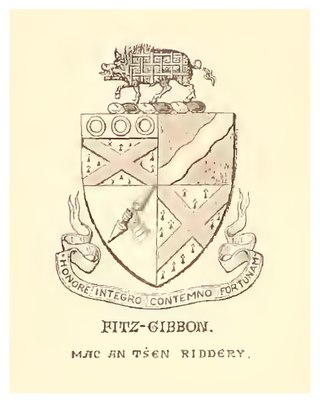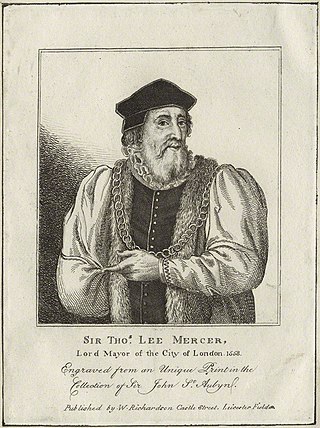Related Research Articles

Earl of Kingston is a title in the Peerage of Ireland. It was created in 1768 for Edward King, 1st Viscount Kingston. The Earl holds the subsidiary titles Baron Kingston, of Rockingham in the County of Roscommon, Viscount Kingston, of Kingsborough in the County of Sligo, Baron Erris, of Boyle in the County of Roscommon, and Viscount Lorton, of Boyle in the County of Roscommon, also in the Peerage of Ireland. He is also a baronet in the Baronetage of Ireland. Between 1821 and 1869 the earls also held the title Baron Kingston, of Mitchelstown in the County of Cork, in the Peerage of the United Kingdom.
John Burke was an Irish genealogist, and the original publisher of Burke's Peerage. He was the father of Sir Bernard Burke, a British officer of arms and genealogist.

The White Knight is one of three Anglo-Norman hereditary knighthoods within Ireland dating from the medieval period. The title was first conferred upon Maurice Fitzgibbon in the early 14th century. The other two knighthoods, both in the Fitzgerald family, are the Knight of Glin, which has become dormant after 700 years, and the Knight of Kerry, which is held by Adrian FitzGerald, 6th Baronet, 24th Knight of Kerry.
Sir Matthew Deane, 3rd Baronet was an Irish baronet and politician.

Sir Thomas Leigh was an English merchant and Lord Mayor of London in 1558-59. He served as a City Alderman from 1552 until 1571.
Sir John Russell, 3rd Baronet, first a Royalist, but afterwards a colonel of foot for Parliament and distinguished himself at the Battle of Marston Moor, and in the Protectorate's wars in Ireland and Flanders.
Sir William Parsons, 1st Baronet of Bellamont, PC (Ire), was known as a "land-hunter" expropriating land from owners whose titles were deemed defective. He also served as Surveyor General of Ireland and was an undertaker in several plantations. He governed Ireland as joint Lord Justice of Ireland from February 1640 to April 1643 during the Irish rebellion of 1641 and the beginning of the Irish Confederate War.
Richard Wingfield, 1st Viscount Powerscourt, PC was an English-born army officer and military administrator during the reigns of Elizabeth I and James I. He is notable for his defeat of Sir Cahir O'Doherty's forces at the 1608 Battle of Kilmacrennan during O'Doherty's Rebellion in Ireland.
Sir Oliver St George, 1st Baronet was an Irish Member of Parliament.
Arthur Annesley, 1st Earl of Mountnorris FRS was an Irish peer.
Cormac na Haoine MacCarthy Reagh, 13th Prince of Carbery (1490–1567) was an Irish chieftain who owned almost half a million acres in south west Ireland.
Sir Henry Osborne, 11th Baronet, was an Irish baronet and politician.

James fitz John FitzGerald, 13th Earl of Desmond, also counted as the 14th, ruled 22 years, the first 4 years as de facto earl until the death of James FitzGerald, de jure 12th Earl of Desmond, called Court Page, who was murdered by James fitz John's brother Maurice fitz John FitzGerald, called Totane. James fitz John FitzGerald maintained himself in power by skilful diplomacy, avoiding armed conflict and destruction. He was appointed Lord Treasurer of Ireland in 1547.

Sir Thomas Osborne, 5th Baronet, of Tichenor, County Waterford was an Irish baronet and landowner.
John King, 1st Baron Kingston was an Anglo-Irish soldier during the Wars of the Three Kingdoms who served the Commonwealth government during the Interregnum and government of Charles II after the Restoration.
Mary Paulet, Lady Cromwell was an English noblewoman, the daughter of John Paulet, 2nd Marquess of Winchester of Basing, Hampshire and his first wife Elizabeth, daughter of Robert Willoughby, 2nd Baron Willoughby de Broke by his second wife, Dorothy, daughter of Thomas Grey, 1st Marquess of Dorset.

The Lyttelton family is a British aristocratic family. Over time, several members of the Lyttelton family were made knights, baronets and peers. Hereditary titles held by the Lyttelton family include the viscountcies of Cobham and Chandos, as well as the Lyttelton barony and Lyttelton baronetcy. Several other members of the family have also risen to prominence, particularly in the field of cricket.

Sir Charles MacCarthy, 1st Viscount of Muskerry, also called Cormac Oge, especially in Irish, was from a family of Irish chieftains who were the Lords of Muskerry, related to the Old English through maternal lines. He became the 17th Lord of Muskerry upon his father's death in 1616. He acquired a noble title under English law, becoming 1st Viscount Muskerry and 1st Baron Blarney under letters patent. He sat in the House of Lords in both Irish parliaments of King Charles I. He opposed Strafford, the king's viceroy in Ireland, and in 1641 contributed to his demise by submitting grievances to the king in London. Muskerry died during this mission and was buried in Westminster Abbey.
Donal MacCarthy Reagh of Kilbrittain was an Irish magnate who owned the extensive lands of Carbery in south-western County Cork.

John de Courcy, 21st Baron Kingsale sat in the House of Lords of the Irish Parliament of 1661–1666.
References
- Burke, Sir Bernard (1855), A Visitation of the Seats and Arms of the Noblemen and Gentlemen of Great Britain and Ireland, vol. 2 (2 ed.), Hurst and Blackett, p. 48
- Shaw, William Arthur (1906), The Knights of England: A complete record from the earliest time to the present day of the knights of all the orders of chivalry in England, Scotland, and Ireland, and of knights bachelors, incorporating a complete list of knights bachelors dubbed in Ireland, vol. 2, London: Sherratt and Hughes
- Lodge, John; Archdall, Mervyn (1789), The Peerage of Ireland: Or, a Genealogical History of the Present Nobility of that Kingdom. With Engravings of Their Paternal Coats of Arms. ... By John Lodge, ... Revised, Enlarged and Continued to the Present Time; by Mervyn Archdall, ..., James Moore, p. 229
- Lundy, Darryl (13 February 2011), Maurice 'Oge' Fitzgibbon, 12th White Knight, The Peerage, p. 38797, retrieved 2 December 2013 cites:
- Montgomery-Massingberd, Hugh (1976), Burke's Irish Family Records, London: Burkes Peerage
- Attribution
 This article incorporates text from this source, which is in the public domain :Burke, John; Burke, Sir Bernard (1844), "Fenton of Mitchelstown", A Genealogical and Heraldic History of the Extinct and Dormant Baronetcies of England, Ireland and Scotland (2 ed.), J. R. Smith, p. 605
This article incorporates text from this source, which is in the public domain :Burke, John; Burke, Sir Bernard (1844), "Fenton of Mitchelstown", A Genealogical and Heraldic History of the Extinct and Dormant Baronetcies of England, Ireland and Scotland (2 ed.), J. R. Smith, p. 605